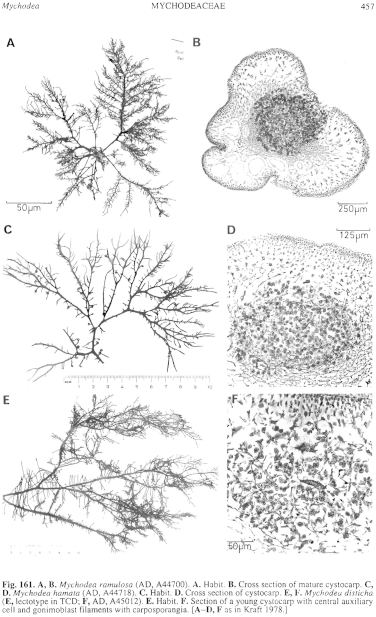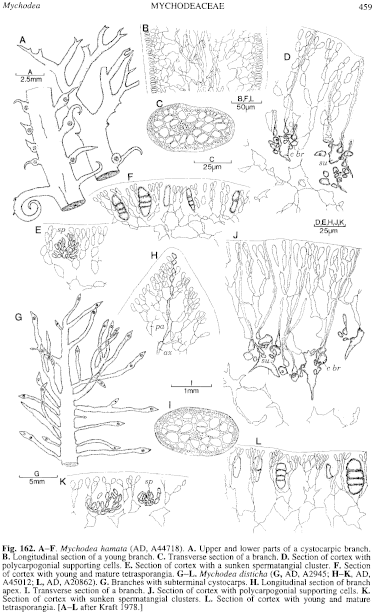|
|
|
|
|
|||||||||||
|
Electronic Flora of South Australia Species Fact Sheet
Phylum Rhodophyta – Class Florideophyceae – Order Gigartinales – Family Mychodeaceae
Selected citations: J. Agardh 1872: 34; 1876: 572. Kraft 1978: 547, figs 14, 15, 37. Kützing 1866: 27, pl. 76a-c. Kylin 1932: 64. Lucas & Perrin 1947: 156.
Synonyms
Acanthococcus ewingii Harvey 1860b: pl. 141; 1863, synop.: xxxvii.
Lecithites rangiferinus (R. Brown in Turner)J. Agardh 1852: 636. [NON Fucus rangiferinus R. Brown in Turner 1811: 114, pl. 183 = Callophyllis rangiferina (R. Brown in Turner)Womersley].
Mychodea obtusangula (Harvey) J. Agardh 1897: 51. Kylin 1932: 65. [NON Acanthococcus obtusangulus Harvey 1863, synop.: xxxvii].
?Gigartina cincinnalis Zanardini 1874: 502. J. Agardh 1876: 205. De Toni 1897: 217. Setchell & Gardner 1934: 135.
Mychodea linearis J. Agardh 1899: 108. Lucas 1929b: 48 (nomen nudum).
Thallus (Fig. 161C) medium to dark red-brown, cartilaginous, 10–20 cm high, forming entangled clumps with compressed subdichotomous axes 1–2 mm broad and irregular branches, with laterals confined to the margins (Fig. 162A), uppermost axes often relatively bare, many branches hamate. Holdfasts discoid, small, arising from lower branches, with numerous hamate branchlets from lower branches attaching to adjacent branches, which may also be attached by haptera. Structure uniaxial, but with an apical dome of cells and without a conspicuous axial filament, developing a central medulla of slender filaments (Fig. 162B, C), an outer medulla of large cells and slender filaments, and a cortex of anticlinal filaments, outer cells elongate-ovoid, 2–4 µm in diameter. Rhodoplasts discoid to elongate.
Reproduction: Sexual thalli monoecious; procarpic; polycarpogonial. Carpogonial branches (Fig. 162D) 3-celled, 2–6 borne on enlarged inner cortical cells, auxiliary cell producing gonimoblast filaments (Fig. 161D) which form clusters of ovoid carposporangia 10–15 µm in diameter, within a filamentous matrix. Cystocarps at the base of short lateral branchlets (Fig. 162A), swollen, 0.8–1 mm in diameter, with moderate enveloping tissue and normal cortex; ostiole absent. Spermatangial clusters (Fig. 162E) embedded in outer cortex of lateral branchlets, with initials producing 1–2 elongate-ovoid spermatangia 2–3 µm in diameter.
Tetrasporangia (Fig. 162F) scattered in the outer cortex, basally attached, elongate-ovoid, 40–50 µm long and 12–20 µm in diameter, zonately divided.
Type from Port Arthur, Tas. (Harvey, March 1855); lectotype in Herb. Harvey, TCD (Alg. Aust. Exsicc. 415K).
Selected specimens: Vivonne Bay, Kangaroo I., S. Aust., drift (Womersley, 2.i.1949; AD, A10625). Port Elliot, S. Aust., drift (Womersley, 17.x.1948; AD, A9371). Cape Jaffa, S. Aust., drift (Womersley, 3.xii.1989; AD, A60039). Robe, S. Aust., 3–4 m deep on jetty piles (R. Lewis & Kraft, 14.v.1972; AD, A44718). Double Corner Beach, Portland, Vic., drift (Beauglehole, 14.vii.1951; AD, A21750). Lonsdale Bight, Port Phillip Heads, Vic., 6–11 m deep (Macpherson, 21.v.1961; AD, A28692). Walkerville, Vic., drift (Sinkora A1601, 23.ii.1972; AD, A43141). Ulverstone, Tas., drift (Perrin, Feb. 1938; AD, A8961). Dover, Tas., 4–6 m deep (Kraft & Sanderson, 8.iv.1988; MELU, K7851). Lady Bay, Southport, Tas., 3–5 m deep (Brown & Womersley, 28.x.1982; AD, A56523).
Distribution: Kangaroo I., S. Aust., to Walkerville, Vic., and around Tasmania.
Taxonomic notes: M. hamata is readily recognised by the distichous branching from compressed axes, and its clumped habit with recurved (hamate) tendrils attaching branches together. It is a common epiphyte on Amphibolis and some larger algae, ranging from larger tide pools to 17 m deep.
Gigartina cincinnalis Zanardini (1874, p. 502), from Port Phillip, Vic. (Mueller) is not a Gigartina but may be Mychodea hamata according to Setchell & Gardner (1934, p. 135). It has not been possible to examine Zanardini's type, but a photograph indicates that may be so.
References:
AGARDH, J.G. (1852). Species Genera et Ordines Algarum. Vol. 2, Part 2, pp. 337–720. (Gleerup: Lund.)
AGARDH, J.G. (1872). Bidrag till Florideernes Systematik. Acta Univ. hind. 8, 1–60.
AGARDH, J.G. (1876). Species Genera et Ordines Algarum. Vol. 3, Part 1 - Epicrisis systematis Floridearum, pp. i-vii, 1–724. (Weigel: Leipzig.)
AGARDH, J.G. (1897). Analecta Algologica. Cont. IV. Acta Univ. lund. 33, 1–106, Plates 1, 2.
AGARDH, J.G. (1899). Analecta Algologica. Cont. V. Acta Univ. lund. 35, 1–160, Plates 1–3.
DE TONI, G.B. (1897). Sylloge Algarum omnium hucusque Cognitarum. Vol. 4. Florideae. Sect. 1, pp. 1–388. (Padua.)
HARVEY, W.H. (1860a). Algae. In Hooker, J.D., The Botany of the Antarctic Voyage. 111. Flora Tasmaniae. Vol. II, pp. 321–343, Plates 185–196.
HARVEY, W.H. (1860b). Phycologia Australica. Vol. 3, Plates 121–180. (Reeve: London.)
HARVEY, W.H. (1863). Phycologia Australica. Vol. 5, Plates 241–300, synop., pp. i-lxxiii. (Reeve: London.)
KÜTZING, F.T. (1866). Tabulae Phycologicae. Vol. 16. (Nordhausen.)
KRAFT, G.T. (1978). Studies of marine algae in the lesser-known families of the Gigartinales (Rhodophyta). III. The Mychodeaceae and Mychodeophyllaceae. Aust. J. Bot. 26, 515–610.
KYLIN, H. (1932). Die Florideenordnung Gigartinales. Lunds Univ. Årsskr. N.F. Avd. 2, 28 (8), 1–88, Plates 1–28.
LUCAS, A.H.S. & PERRIN, F. (1947). The Seaweeds of South Australia. Part 2. The Red Seaweeds. (Govt Printer: Adelaide.)
LUCAS, A.H.S. (1929b). A census of the marine algae of South Australia. Trans. R. Soc. S. Aust. 53, 45–53.
SETCHELL, W.A. & GARDNER, N.L. (1934). De Gigartinis. Rev. Algol. 7, 131–138.
TURNER, D. (1811). Fuci sive Plantarum Fucorum Generi a Botanicis Ascriptarum Icones Descriptiones et Historia. Vol. 3, pp. 1–148, Plates 135–196. (London.)
ZANARDINI, J. (1874). Phyceae Australicae novae vel minus cognitae. Flora (Regensburg) 57, 486–490, 497–505.
The Marine Benthic Flora of Southern Australia Part IIIA complete list of references.
Publication:
Womersley, H.B.S. (14 January, 1994)
The Marine Benthic Flora of Southern Australia
Rhodophyta. Part IIIA, Bangiophyceae and Florideophyceae (to Gigartinales)
Reproduced with permission from The Marine Benthic Flora of Southern Australia Part IIIA 1994, by H.B.S. Womersley. Australian Biological Resources Study, Canberra. Copyright Commonwealth of Australia.
Illustrations in Womersley Part IIIA, 1994: FIGS 161C, D, 162 A–F.

Figure 161 enlarge
Fig. 161. A, B. Mychodea ramulosa (AD, A44700). A. Habit. B. Cross section of mature cystocarp. C, D. Mychodea hamata (AD, A44718). C. Habit. D. Cross section of cystocarp. E, F. Mychodea disticha (E, lectotype in TCD; F, AD, A45012). E. Habit. F. Section of a young cystocarp with central auxiliary cell and gonimoblast filaments with carposporangia. [A–D, F as in Kraft 1978.]

Figure 162 enlarge
Fig. 162. A–F. Mychodea hamata (AD, A44718). A. Upper and lower parts of a cystocarpic branch. B. Longitudinal section of a young branch. C. Transverse section of a branch. D. Section of cortex with polycarpogonial supporting cells. E. Section of cortex with a sunken spermatangial cluster. F. Section of cortex with young and mature tetrasporangia. G–L. Mychodea disticha (G, AD, A2945; H–K, AD, A45012; L, AD, A20862). G. Branches with subterminal cystocarps. H. Longitudinal section of branch apex. I. Transverse section of a branch. J. Section of cortex with polycarpogonial supporting cells. K. Section of cortex with sunken spermatangial clusters. L. Section of cortex with young and mature tetrasporangia. [A–L after Kraft 1978.]

|
Email Contact: State Herbarium of South Australia |

|